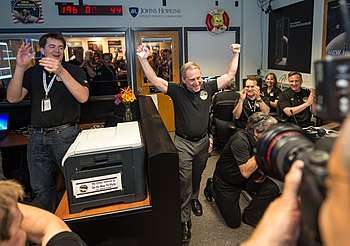Applied Physics Laboratory
The Johns Hopkins University Applied Physics Laboratory, commonly known as simply the Applied Physics Laboratory, or APL, located in Howard County, Maryland, near Laurel and Columbia, is a not-for-profit, university-affiliated research center (or UARC) employing 6300 people (2018). The Lab serves as a technical resource for the Department of Defense, NASA, and other government agencies. APL has developed numerous systems and technologies in the areas of air and missile defense, surface and undersea naval warfare, computer security, and space science and spacecraft construction.[2] While APL provides research and engineering services to the government, it is not a traditional defense contractor, as it is a UARC and a division of Johns Hopkins University. APL is a scientific and engineering research and development division, rather than an academic division, of Johns Hopkins.
 | |
| Established | 1942 |
|---|---|
| Research type | Unclassified / classified |
| Director | Dr. Ralph Semmel |
| Staff | 6300[1] |
| Location | Laurel, Maryland, U.S. |
Operating agency | Johns Hopkins University |
| Website | www |
Hopkins' Whiting School of Engineering offers part-time graduate programs through its Engineering for Professionals program. Courses are taught at seven locations in the Baltimore-Washington Metropolitan Area, including the APL Education Center.[3]
History
APL was created in 1942 during World War II under the Office of Scientific Research and Development as part of the Government's effort to mobilize the nation's science and engineering expertise within its universities. Its founding director was Merle Anthony Tuve. The Laboratory succeeded in developing the variable-time proximity fuze[4] that played a significant role in the Allied victory.[5] In response to the fuze's success, the APL created the MK 57 gun director in 1944. Pleased with the APL's work, the Navy then tasked it with the mission to find a way to negate guided missile threats. From there on, the APL became very involved in wartime research.[6] Expected to disband at the end of the war, APL instead became heavily involved in the development of guided missile technology for the Navy. At governmental request, the University continued to maintain the Laboratory as a public service.
APL was originally located in Silver Spring, Maryland in a used-car garage[7] at the former Wolf Motor Company building at 8621 Georgia Avenue.[8] APL moved to Laurel beginning in 1954, with the construction of a two million dollar building and a US$700,000 wing expansion in 1956.[9] The final staff transitioned to the new facility in 1975.[7][10] Before moving to Laurel, APL also maintained the "Forest Grove Station", north of Silver Spring on Georgia Avenue near today's Forest Glen Metro,[11] which included a hypersonic wind tunnel. The Forest Grove Station was vacated and torn down in 1963 and flight simulations were moved to Laurel.
The Laboratory's name comes from its origins in World War II, but APL's major strengths are systems engineering and technology application. More than three-quarters of the staff are technical professionals, and 25% have computer science and math degrees. APL conducts programs in fundamental and applied research; exploratory and advanced development; test and evaluation; and systems engineering and integration.
Wartime contributions
During the 1950s and the 1960s APL worked with the US Navy in the Operation Bumblebee Program on the Talos missile, Tartar missile, Terrier, and RIM-2 Terrier Surface to Air Missile systems. The follow-on RIM-50 Typhon Missile Project, based on improved Talos and Tartar Missiles, while successful, was cancelled in 1963 due to high costs and was eventually developed into the now well known Aegis Combat System based on an improved Terrier.
In 1990, APL became involved with Operation Desert Storm and was involved in the Gulf Crisis Room among other efforts. In the same decade (1992), APL, along with Johns Hopkins University, developed an algorithm that allowed for automatic mammogram analysis.[6]
Pershing
In 1965, the US Army contracted with APL to develop and implement a test and evaluation program for the Pershing missile systems.[12] APL developed the Pershing Operational Test Program (OTP), provided technical support to the Pershing Operational Test Unit (POTU), identified problem areas and improved the performance and survivability of the Pershing systems.[13]
Campus
The modern Applied Physics Laboratory is located in Laurel, Maryland, and spans 453 acres with more than 30 buildings on site. Additional auxiliary campuses exist in the surrounding areas.[14]
Education
APL is also home to a Johns Hopkins graduate program in engineering and applied sciences, called Engineering for Professionals.[15] Courses are taught at seven locations in the Baltimore-Washington Metropolitan Area, including the APL Education Center.[3]
Research
As of APL's 70th anniversary in 2012, there were over 600 projects in progress, spanning from those in APL's more traditional areas of work, including air defense, undersea warfare precision engagement and strategic systems to newer types of projects, including those in homeland security and cyber operations.[6] Due to the nature of the APL's work, many of its projects' details are kept confidential.
Defense
The U.S. Navy continues to be APL's primary long-term sponsor. The Laboratory performs work for the Missile Defense Agency, the Department of Homeland Security, intelligence agencies, the Defense Advanced Research Projects Agency (DARPA), and others. The Laboratory supports NASA through space science, spacecraft design and fabrication, and mission operations. APL has made significant contributions in the areas of air defense, strike and power projection, submarine security, antisubmarine warfare, strategic systems evaluation, command and control, distributed information and display systems, sensors, information processing, and space systems.
Space

APL has built and operated many spacecraft, including the TRANSIT navigation system, NEAR, Geosat, ACE, TIMED, CONTOUR, MESSENGER, Van Allen Probes,[16] the New Horizons mission to Pluto, the Parker Solar Probe mission to the outer corona of the Sun,[17] and STEREO.[16] In 2019, the APL proposed Dragonfly mission was selected as the fourth NASA New Frontiers mission.[18][19] Dragonfly is a lander for Saturn's moon Titan that will fly using rotors in a dual-quadcopter configuration to move around the moon's surface.
The asteroid 132524 APL was named in honor of APL after a flyby by the New Horizons spacecraft.
Prosthetics
In 2014, APL made history with the successful use of the Modular Prosthetic Limb — a fully artificial articulated arm and hand — by a bilateral shoulder-level amputee. APL used pattern recognition algorithms to track which muscles were contracting and enable the prosthetics to move in conjunction with the amputee's body.[20]
Similar technology was used in 2016 for a demonstration in which a paralyzed man was able to "fist-bump" Barack Obama using signals sent from an implanted brain chip.[21] The limb returned sensory feedback from the arm to the wearer's brain.
Drones
The APL researches and produces unmanned aerial vehicles for the US military.[22] One of its most recent projects is an unmanned aerial swarm that can be controlled by a single operator on the ground.[23]
See also
References
- "About APL". Johns Hopkins University Applied Physics Laboratory. Retrieved October 1, 2018.
- "Archived copy". Archived from the original on January 20, 2016. Retrieved January 17, 2016.CS1 maint: archived copy as title (link)
- "APL Education Center". Johns Hopkins University Applied Physics Laboratory. Archived from the original on April 20, 2013. Retrieved October 15, 2008.
- Simpson, Joanne (April 2000). "The Funny Little Fuze with Devastating Aim". Johns Hopkins Magazine. Johns Hopkins University.
- "Our History". JHU APL. Johns Hopkins University. Archived from the original on October 15, 2013. Retrieved March 12, 2015.
- "APL at 70". JHU APL. 2012. Archived from the original on October 15, 2013. Retrieved March 12, 2015.
- http://www.jhuapl.edu/techdigest/td2104/hagler.pdf Archived September 11, 2006, at the Wayback Machine
- McCoy, Jerry A; Society, Silver Spring Historical (November 2005). Historic Silver Spring. ISBN 978-0-7385-4188-4.
- "Johns Hopkins Lets Contract in Md". The Washington Post. March 27, 1955.
- The Johns Hopkins Gazette: March 25, 2002
- Google Maps
- Mentzer, Jr., William R. (1998). "Test and Evaluation of Land-Mobile Missile Systems" (PDF). Johns Hopkins APL Technical Digest. Johns Hopkins University. Archived from the original (PDF) on March 4, 2016. Retrieved December 2, 2014.
- Lyman, Donald R. (May–June 1977). "POTU: Testing Pershing in Europe and CONUS" (PDF). Field Artillery Journal: 15–17.
- "About:JHU|APL".
- "JHU Graduate Program in Engineering and Applied Sciences". JHU APL. Archived from the original on April 20, 2013. Retrieved March 24, 2015.
- "Space Press Releases". JHU APL. Retrieved March 12, 2015.
- "Parker Solar Probe: A Nasa Mission to Touch the Sun". JHU APL. March 18, 2014. Retrieved August 18, 2017.
- NASA selects Titan drone for next New Frontiers mission. Jeff Foust, Space News. June 27, 2019. Retrieved July 6, 2019.
- NASA's Dragonfly Will Fly Around Titan Looking for Origins, Signs of Life. NASA. June 27, 2019. Retrieved July 6, 2019.
- "Amputee Makes History with APL's Modular Prosthetic Limb". JHU APL. December 16, 2014. Retrieved March 12, 2015.
- "Watch Obama fist bump a robotic arm powered by a brain chip". NBC News. Retrieved July 21, 2018.
- "Drone Research and Robotic Warfare: The Hopkins Connection". Today's Announcements. Johns Hopkins University. April 20, 2012. Retrieved August 13, 2012.
- Manufacturing Group (August 13, 2012). "Demonstrating Expanded Control of UAV Swarm". Aerospace Manufacturing and Design.
Boeing and the Johns Hopkins University Applied Physics Laboratory (JHU/APL) have demonstrated that an operator on the ground, using only a laptop and a military radio, can command an unmanned aerial vehicle (UAV) "swarm". Despite limited flight training, the operator was able to connect with autonomous UAVs, task them and obtain information without using a ground control station. [...] The demonstrations are conducted under a collaborative agreement between Boeing and JHU/APL, a University Affiliated Research Center and a division of Johns Hopkins University that has been addressing critical national challenges through the innovative application of science and technology for nearly 70 years. It maintains a staff of about 5,000 on its Laurel, Maryland, campus.